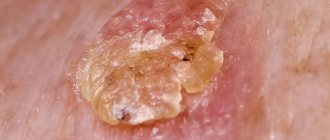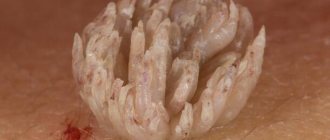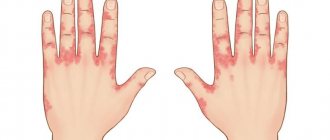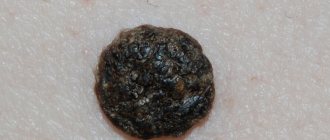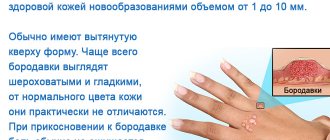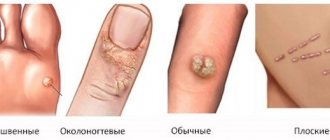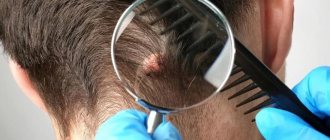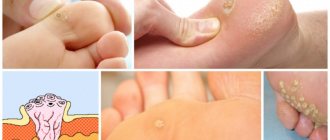Papillomas on the hands occur due to infection with papillomavirus (HPV). These are small tumors that cannot be treated, but there is a way to stop their development and also prevent the formation of new growths.
If papillomas are located in areas of the skin where they are constantly injured, for example, on the bend of the hand or fingers, they are removed. This can be done by a specialist; in this case, the root of the growth will not remain in the epithelial layer. It is acceptable to remove papillomas yourself, but in most cases the formations partially remain in the upper layers of the skin, which is dangerous.
Types and causes of appearance
There are more than 100 types of HPV virus, only some of them are dangerous because they are oncogenic. Such infections usually affect mucous membranes, such as the genitals. As a result, genital warts are formed. But three types of papillomas form on the fingertips, joints, palms and back of the hand:
- flat;
- ordinary;
- periungual.
In each case, the signs of neoplasms will differ:
- Flat ones are characterized by smooth edges, a smooth surface, and a pinkish or light brown tint.
- Ordinary papillomas on the fingers have a loose texture and are irregular in shape, but in most cases they are round.
- Periungual growths are localized near the nail plate, as they usually form here due to the habit of biting nails.
More warts appear on the hands. They are provoked by papillomavirus, but of a different type. A wart can be removed using the same methods as papillomas. To accurately determine the type of neoplasm, you should look at the photo.
The human papillomavirus enters the body in different ways:
- contact and household (when using other people's hygiene items, personal belongings, when shaking hands);
- sexual;
- During labor, the virus is transmitted from mother to child.
There are factors that provoke an increase in viral activity. The fact is that papillomavirus can remain in the human body for a long period without showing itself in any way. Under certain conditions, HPV begins to develop, which leads to the appearance of growths on the hands. Reasons for increased viral activity:
- weakened immunity;
- hormonal changes, including during pregnancy and lactation;
- antibiotic therapy;
- disorders of the gastrointestinal tract;
- infectious diseases;
- regular intense stress;
- frequent deformations of the upper layer of the skin, for example during a manicure.
Symptoms of the disease
How to understand that HPV infection has occurred? The very first sign is the appearance of neoplasms. There are several types of papillomas on the hands:
- Vulgar (simple) - the most common type. They are small lumps that appear first on the hands and fingers, and then can spread throughout the body.
- Flat – angular neoplasms. Their appearance is accompanied by severe itching and inflammation of healthy skin around.
Papillomas can grow in colonies on the palms. This is the most dangerous type of growth, since it is inherited and has a tendency to degenerate.
The skin at the site of the future growth changes - it becomes rough, dense due to increased keratinization, changes color (takes on either a pinkish or white tint).
Gradually, a tumor forms from epithelial cells and begins to grow in size. Over time, several more neoplasms may appear near it, and a whole colony will form.
Papillomas on the face (photo)
These benign growths are often located in areas where the skin is thinnest: near the eyes, around the nose and mouth. And on men’s chin in the shaving area.
The growths may appear one at a time or in groups. In appearance, these are rounded outgrowths similar to elongated papillae or cauliflower.
Papillomas on the face are pink or brownish in color.
First, a tiny bump appears on the surface of the skin, similar to a pimple. Gradually it increases in size, growing upward and to the sides. The papilloma reaches up to 3 cm in diameter. Its base is narrower, and its cap is rounded and lumpy.
If in women papilloma on the face causes mainly aesthetic problems, then in men everything is more complicated. The growths are constantly injured during shaving, and this can cause serious inflammation.
A person becomes infected through physical contact with a sick person. This could be hugs, sexual contact, or, for example, through shared towels.
From the moment of infection until papillomas appear on the face, it can take from 3 months to a year. Often growths form on the skin after infections, severe stress, hypothermia, during pregnancy, when immunity declines.
Papillomas on the skin of the neck and body (photo)
Genital papillomas are most often caused by types 6 and 11 of the virus. These growths are also called genital warts.
Anal condylomas
These small growths may appear around the anus. They are light pink or reddish brown in color and small in size, 1-3 mm. They are found in groups and can cover large areas, growing in the shape of a cockscomb.
Condylomas cause itching, irritation and bleeding after injury, for example, with toilet paper.
Condylomas on the penis
In men, genital warts grow on the penis and scrotum. One of the most common areas of condylomas is the coronal sulcus of the penis and the frenulum, less often the head.
The appearance of genital warts is easy to detect during external examination. If you notice them, it is better to immediately consult a urologist-andrologist.
The base of condylomas is wider, and the apices are pointed. The growths are painless and soft to the touch. However, they can cause discomfort during intimacy.
At first, one or more tiny growths appear. They grow and new condylomas form around them. If treatment is not started in time, the rash can spread not only to the genitals, but also to the groin folds. This disease can cause penile cancer.
Condylomas on the genital organs in women
Condylomas in women can appear on the labia majora and minora, at the entrance to the vagina, inside it and on the cervix. They often appear as pearly white, wide hairs with a pointed top.
At their base, a clear liquid with an unpleasant odor is secreted. After their appearance, the woman experiences itching and discomfort, especially during sex.
After sexual intercourse, there may be a slight discharge of blood from the vagina. This indicates that the condylomas have been injured.
If you find these small growths, you need to be examined by a gynecologist. In 2-5% of cases, genital warts on the cervix can cause cancer. Therefore, it is worth visiting a doctor, even if the growths do not cause discomfort.
Condylomas on the tongue
Genital warts on the tongue can also appear after sexual intercourse. These are small single elements or rather large growths. A person feels a growth on the tongue, but does not pay attention, mistaking it for a taste bud.
Such genital warts often appear in women on the mucous membrane of the tongue, lips and on the skin around the mouth. This can significantly spoil your appearance and cause a lot of complexes. Like other forms of rashes, this one requires complex treatment.
If a person does not know what papillomas on the hands look like, photos of them can give a general idea of the disease, which can be easily found in the literature and the Internet. Often warts or vulgar papillomas appear on these areas of the body. They can spread from a healthy person to a sick person.
Often these objects grow on the skin where there has been at least minor damage. The spread of papillomas near the nails is typical. It may take several months from infection to the appearance of the first clinical symptoms.
On the hands, such formations have their own characteristics. So, they have a flat appearance and fit tightly on the skin.
They don't have legs. Often the formations in question have a yellow tint with a horny surface.
They are rough and dense to the touch. With multiple infections, they can merge, forming one continuous foreign object.
The characteristic features of papillomas on the hands are as follows:
- they do not hurt or cause discomfort;
- the skin pattern disappears on the surface of the papilloma;
- new warts have a smooth, shiny surface, while old ones have a horny surface, consisting of dead cells;
- sometimes dark dots are visible on the surface (they appear due to thrombosis of the capillaries).
In children, such papillomas appear on the skin more often. This is due to the characteristics of the immune system. Children's skin is thinner, which means it is more exposed to the virus.
Symptoms
The main sign of infection with the HPV virus is the formation of papillomas in different parts of the body, including the upper extremities. Other characteristic symptoms:
- thickening of the epithelial layer and its keratinization in places where growths appear;
- the formation of excess tissue is accompanied by itching;
- sometimes pain appears at the site of papilloma;
- Another sign of the spread of the virus is an increase in the number of neoplasms.
Under the influence of a number of factors, papillomas on the hands degenerate from benign to malignant. This occurs when pressure is constantly placed on excess tissue. In addition, the risk of developing oncology increases in cases where the papilloma is injured and its integrity is compromised. Signs of a dangerous condition: redness of the growth, swelling in this area, pain when touched.
Traditional methods of treating warts
Papillomas on the hands can also be treated using traditional methods. Lubricating papillomas with celandine juice, rowan berries, milkweed juice, castor oil, etc. gives good results. Typically, this is a chemical type of removal.
Before the procedure, hands should be steamed in hot water and wiped dry. A few recipes will help you avoid getting lost in the situation.
- Every day, drip a drop of vinegar essence onto the wart.
- Rub the wart with garlic juice.
- Apply a piece of propolis to the neoplasm and bandage it for three to four days. First you need to steam your hand in hot water with soda. After removing the bandage, the hand is hovered in the same solution, the wart is easily separated. If not, repeat the procedure until the result is obtained. The recipe can be modified; instead of propolis, use a cake mixture of crushed garlic cloves, a spoonful of acetic acid, and wheat flour. Place the cake exactly on the wart. If the mixture comes into contact with the skin, it may cause severe burns. The bandage should not be removed for three days until the wart falls off. If the first procedure does not help, you need to repeat it.
- Make hot baths from thyme infusion at the rate of 1 tbsp. spoon of dry herb per 1 glass of water. The infusion should be very hot, your hands should steam in it for an hour. There are 14 procedures for treatment.
- Apply a mixture of vinegar essence and charcoal.
- Lubricate with pure celandine juice.
- Lubricate with a mixture of hemp oil and honey at a ratio of one to four.
Garlic juice is a safe folk method for removing growths
The peculiarity of folk recipes is that their use begins on the full moon and lasts until the new moon. If the course needs to be repeated, then start again with the new moon.
If the wart begins to turn black, its roots die off and the virus is killed. But the wart should fall off on its own. If it is picked or cut, a relapse is possible.
Treatment methods
If the process of formation of excess tissue in the upper layers of the outer integument has already begun, there is no way to prevent the appearance of papilloma.
You can only stop the process of development of the virus, then other neoplasms will not appear on your hands. For this purpose, different types of drugs are used:
Antiviral agents. Such drugs do not get rid of the virus, as it might seem, judging by the name alone. HPV is very difficult to overcome; to do this, it is necessary to eliminate all factors contributing to its development and further increase immunity. Antiviral drugs block the activity of the virus, preventing it from multiplying. The components in such drugs usually act as inhibitors of viral DNA synthesis. This allows you to temporarily stop the spread of infection.
- Immunostimulating agents. Such drugs are part of maintenance therapy. They are prescribed to boost immunity, because taking antiviral drugs against the background of weakened protective functions of the body will not give the desired results.
Examples of drugs that suppress viral activity: Acyclovir and drugs based on the substance of the same name (Zovirax, etc.), Valacyclovir, Valtrex, Famciclovir. Effective immunostimulants containing interferon: Genferon, Viferon. Complex-action drugs are also used, for example, Isoprinosine. Such medications help increase the body's defenses and at the same time block viral activity.
Diagnostics
Before treating the affected tissues where papillomas grow, it is necessary to conduct a thorough diagnosis. To do this, you need to visit the office of a dermatologist, who will conduct a visual examination. The doctor carefully examines the affected area, and then performs the following manipulations if necessary:
- blood test using PCR technique;
- DNA diagnostics for HPV, which allows you to determine the type of virus and its possible malignancy.
There are a large number of strains of this virus, some of which are oncogenic. Do not put off treatment for a long time: it is better to immediately visit a dermatologist for a diagnosis. Often, warts are the result of exposure to molluscum contagiosum, lichen planus or warty tuberculosis, so it is important to make a high-quality diagnosis.
How are papillomas on the hands removed?
Unlike tumors on the mucous membranes of the genital organs, growths on the skin, and especially on the fingers and the back of the hand, can be removed by any existing means. This is due to the fact that in some cases scars remain on the mucous membranes, which can have negative consequences. To get rid of papillomas on the hands, they resort to the following methods:
- Cryodestruction. In this case, liquid nitrogen is used. The procedure is characterized by a minimal level of pain and no bleeding, as damaged blood vessels are soldered together, so no blood is released when the papilloma is removed. The disadvantage of the procedure is the difficulty of accurately determining the desired depth of action of the liquid nitrogen applicator. As a result, the growth may not be completely removed.
- Radio wave method. This is an effective procedure, but it is not performed for oncology.
- Laser therapy is a modern and effective way to remove papillomas. It is characterized by the absence of pain and does not provoke bleeding. The wound heals quickly.
- Electrocoagulation. In this case, the papilloma is affected by electric current. The procedure is performed under local anesthesia.
- Excision of excess tissue with a scalpel. It is advisable to choose this method in cases where the growth is quite large - up to 2 cm. This is the least common method of removing papillomas, since the procedure is painful, and the wound in this case takes longer to heal.
Chemical cauterization
There are special medications that help fight growths on the hands and other parts of the body. If a papilloma appears on a finger or the back of the hand, you can contact a specialist who will remove the defect using pharmaceutical preparations. It is permissible to use such products at home, however, in this case, the risk of incorrect, partial removal increases, which can cause the development of oncology. Preparations for chemical cauterization:
Solcoderm. Available as a solution for external use. The kit includes applicators that simplify the procedure for removing growths. Scars may remain after using this product. Use Solcoderm after disinfecting the area with papilloma. A small amount of the product is applied to the skin; healthy tissue surrounding the growth should not be treated.
- Feresol. The drug contains phenol and tricresol. It is characterized by cauterizing and bactericidal effects. Papillomas must be treated continuously for 10–60 minutes. The duration of the procedure depends on the size of the growth.
- Kolomak. This remedy is a group of keratolytics, which means it can soften tissue, which leads to the removal of growth. Contains polidocanol and lactic acid. The first of the substances anesthetizes, the second promotes removal.
- Super clean. This is a solution that removes any neoplasms, including papillomas, from the skin of the hands. It is applied in small portions to excess tissue without affecting healthy skin. Treatment with Supercleaner is carried out over several days.
Prevention
Once infected with this virus, it is unlikely that you will be able to get rid of HPV, because it can remain in the body in a latent state for decades and wait for the immune system to weaken. Therefore, prevention of papillomavirus is of great importance. This is especially important for women, because it can successfully prevent the development of cervical cancer. Among the main preventive measures for this virus are:
- All kinds of ways to increase the protection of the body's immune system;
- Compliance with personal hygiene rules;
- Passing medical examinations;
- Sex education for the growing generation;
- Use of vaccines.
Now on the Internet you can find many photos of papilloma on the arm and other parts of the body with a full description of methods for treating this viral disease. Before any independent treatment option, a consultation with a doctor will not be superfluous; moreover, it will allow you to quickly discard ineffective methods, thereby saving you time, money, and in some cases, even, most importantly, health.
To avoid catching HPV in public institutions, you should try to use only your personal hygiene items and thoroughly wash your hands and other areas of skin that were in contact with other people after each visit to such institutions. It is extremely important to protect yourself during sexual contact. It is worth remembering that it takes a certain time for the virus to penetrate the epithelium, so if you take the necessary measures, you can quite effectively combat its entry into the body.
Traditional medicines
You can speed up the healing process if you treat papillomas using home remedies. At the same time, herbal infusions/decoctions are prepared, which help to increase the body’s protective functions, and also use means to treat growths. Recipes:
- Garlic. Take 2-3 cloves, chop them and add the pulp to baby cream (1 tsp). The prepared mixture is applied to the tumor for several hours. On top you need to put a bandage pre-folded in 3-4 layers and secure with a bandage.
- The celandine is crushed, the juice is obtained and the papillomas on the hands are treated. During the first week, it is necessary to repeat the procedure 3-4 times, after which the frequency of use of the product is reduced to 2 times a day.
- A decoction for oral administration based on lemon balm, nettle, horsetail, dandelion and plantain. The components are taken in equal shares. To prepare the product, prepare 1 tbsp. l. collection, 1 tbsp. water. The components are combined. It is better to prepare the decoction in an enamel bowl. The mixture is brought to a boil, removed after 10 minutes, and left to infuse. To cure papillomas, take the medicine 2-3 times a day, 50 ml.
You can simultaneously use a decoction to improve immunity and agents that help remove the growth.
